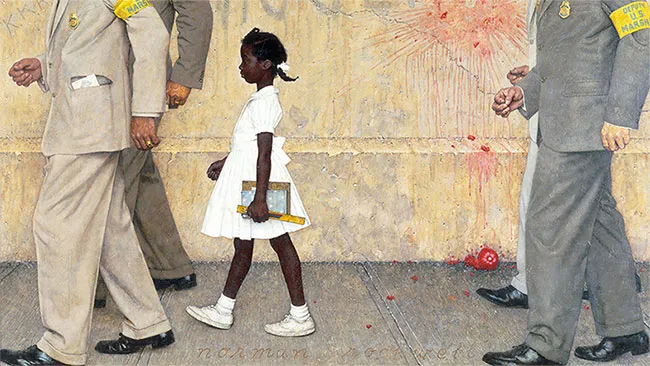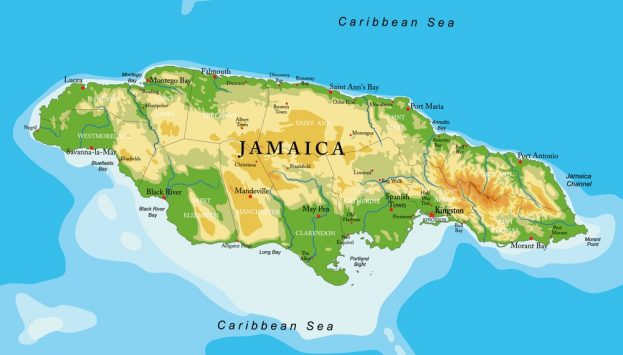
White racism in America, at the outset, barred people of colour from partaking of the fruits of freedom and equal opportunity, fruits enjoyed, in the main, by white America through the force of laws. This is an indisputable fact of history. Racism even sought to use a bastardized history to support its claim.
Racism then, with sinister and artful intent, began to use race to maintain the very disadvantages and inequities that were brought on under its auspices as justification to continue denying such access by nullifying laws created to bring about a more level playing field. This it did, ironically, with a willful disregard for bonafide history which recorded all it had ever done against Afro-Americans and other minorities.
What was even more tragic than the perpetration of the crime of racism was when Afro-Americans, its victims, began to aid and abet it, whether through sheer ignorance or through a tortuous reasoning used in their attempts at self-affirmation in the face of it. In the case of such individuals racism not only managed to confuse and destroy their self-esteem, but helped to rebuild it with a new and intense love for whiteness and, conversely, with a new, vociferous and unconscious hatred of themselves. Such individuals pose not only a danger to themselves, but to others when they are vested with great authority. Associate Supreme Court Justice Clarence Thomas has been counted by many as one such person of colour, one who is a champion of white racism.
The Justice’s lack of popularity in the Afro-American community is real and shows no signs of improving anytime soon. The legacy that he is creating on the court is a serious departure from that which was left by his predecessor and fellow Afro-American, the late Justice Thurgood Marshall. Justice Thomas, having been placed on the court, in all fairness, should not be there to help it propagate or promulgate anything that could be seen as a “Black agenda”, but to interpret the Constitution of the United States so as to protect the rights of all Afro-Americans and, indeed, of all Americans. It is upon this premise, therefore, that he should be judged by posterity and on nothing else.
If Justice Thomas’ opinions, therefore, happen to concur with those of any majority on the court — ones which unjustly hurt Afro-Americans and other minorities, whether this was so intended or not, or if he writes dissenting opinions, being a part of any minority, which telegraph a desire to do harm to the Afro-American community or other minorities — then he should be excoriated and vilified accordingly.
Justice Thomas being a part of the majority which recently shot down affirmative action on the basis of race in respect to college admissions is a case in point. In the abstract, and on the surface, the ruling appears to foster a “race neutral” approach to jurisprudence, but its outcomes will only serve to perpetuate the dire racist effects which the law sought to prevent in the first place. All the socio-political and economic forces which prevented, stymied or handicapped the access of Afro-Americans —with ambition and ability — to education or to other fields of endeavour or to resources which were formerly reserved for whites will go unchecked as a result.
The current Supreme Court, with a conservative super majority of which Justice Thomas is a part, says that the 14th Amendment should be enough. But the Afro-American community and those sensitive to the issues of Black people know that America has had a woeful anaemia of will and of effort in respect to applying what is on the books to real life situations. As with the voting rights bill, named after the late U.S. congressional representative John Lewis, one which is yet to be passed, one intended to do what America failed to do with respect to the 15th Amendment, so was the case with affirmative action in respect to the 14th Amendment. In the abstract, “race neutral” laws, as asserted by the Supreme Court, is a vapid theory, one loosed from the moorings of history, but in practice, one which only serves to maintain the white racist status quo.
The 14th Amendment, which was passed by the U.S. Senate in 1866 and which was ratified two years later, granted citizenship to all persons “born or naturalized in the United States,” including formerly enslaved people, and provided all citizens with “equal protection under the laws”. The same law designed to protect Afro-Americans and other minorities has not been upheld by the Supreme Court under Chief Justice John Roberts, a court that, for political and economic advantage to those on the right, ruled in 2010 that corporations have, in essence, the same identity, rights and privileges as individual citizens, particularly in respect to their political campaign contributions.
Affirmative action is not a new concept to politics or jurisprudence on the American landscape. White America has benefited from it in many ways and over many decades, including the area of education. One only needs to recall the Brown versus the Board of Education ruling of 1954, which is still not fully in effect. Whether it had to do with being able to secure land during land reform since the 1800s, or to adequate housing, two benefits among others which fall under affirmative action, Afro-Americans never gained an equal share which was representative of the ratio in which they find themselves in the make-up of the American population. Affirmative action, which, belatedly, included race as a protected class, sought to address this problem, and there is no doubt that Justice Thomas, as smart as he is, was quite aware of that fact.
Let us, for example, look at land ownership in the United States today, in order to illustrate the glaring disparity of land distribution on racial terms. The following article published on June 15, 2021, by The Regulatory Review — A Publication of the Penn Program on Regulation stated that:
“Protests against racialized police brutality spread across the world in May 2020, igniting a widespread reckoning with systemic racism. Yet here in America, one form of racial inequality requires more public and political discussion: the need for land reform.
Striking racial inequalities exist in who owns, operates, and benefits from America’s farmland. Private individuals or corporations own two-thirds of land in the United States, and the U.S. Government owns about one-third. As of 2012, white Americans owned 98 per cent of America’s privately owned farmland — approximately 856 million acres, worth about $1 trillion.
White Americans operate 94 per cent of privately owned farmland. Black Americans own less than 1 per cent of U.S. farmland, worth about $14 billion. Farmers of colour are much more likely to be tenant farmers, who are much less likely to generate wealth from their farm work.”
The article went on to provide more staggering data to illustrate the vast disparities between whites and Blacks with respect to land holdings. But it did not stop there, as it went on to put the reality of the data collected in respect to this issue within the context of U.S. history. It was history, no doubt, that Justice Thomas was taught in school, as one that was properly scrutinized and accepted by historians worth their salt:
“How did the country get here? White American settlers and their descendants have always had the upper hand in land control, ever since the nation was founded. Indigenous land dispossession and enslavement of Black people were the basic building blocks of these settlers’ wealth accumulation, entwined in the interdependent settler-native-slave triad of settler-colonialism that pushed white settlers ahead of the wealth game from the beginning.
Even after the abolition of slavery, the U.S. Department of Agriculture (USDA) has maintained a long history of discriminating against Black farmers by denying them access to loans. Black farming peaked in 1910 when 14 per cent of farmland was owned by Black Americans. The number has dwindled over time as a result of lending discrimination, culminating in a class action lawsuit and ultimately a settlement that awarded more than a billion dollars in relief.”
This, too, was a part of affirmative action, along with the New Deal programmes which came into being under President Franklin D. Roosevelt, including the G.I. Bill, signed into law in 1944, which disproportionately favoured white veterans of World War II over veterans of colour. Affirmative action did not become anathema to white America until it highlighted the needs of the Afro-American community which has and which continues to lag behind whites in that regard. So what, then, motivated Justice Thomas to vote against his own kind?
In a legal opinion that he wrote on June 12, 1995, Justice Thomas, concurring in part and concurring in the judgment, wrote:
“I agree with the majority’s conclusion that strict scrutiny applies to all government classifications based on race. I write separately, however, to express my disagreement with the premise underlying Justice Stevens’ and Justice Ginsburg’s dissents: that there is a racial paternalism exception to the principle of equal protection. I believe that there is a ‘moral [and] constitutional equivalence,’…between laws designed to subjugate a race and those that distribute benefits on the basis of race in order to foster some current notion of equality. Government cannot make us equal; it can only recognize, respect, and protect us as equal before the law.
That these programmes may have been motivated, in part, by good intentions cannot provide refuge from the principle that under our Constitution the Government may not make distinctions on the basis of race. As far as the Constitution is concerned, it is irrelevant whether a government’s racial classifications are drawn by those who wish to oppress a race or by those who have a sincere desire to help those thought to be disadvantaged. There can be no doubt that the paternalism that appears to lie at the heart of this programme is at war with the principle of inherent equality that underlies and infuses our Constitution.”
“In my mind, government-sponsored racial discrimination based on benign prejudice is just as noxious as discrimination inspired by malicious prejudice. In each instance, it is racial discrimination, plain and simple.”
Having read that opinion in full, this writer was drawn to Justice Thomas’ usage of the word “paternalism”, which he used not less than three times, and of the word “patronizing” which he used once. They represent his own paternalism in respect to his own race by his legal opinion. This writer also recalls how he bristled when asked if he had ever benefited from affirmative action at his confirmation hearing, and suspects that he was writing his opinion from his own story of pain, in reaction to the petty slights and the malicious putdowns expressed to him in respect to his academic and professional achievements, linking them to affirmative action, a term twisted by whites and used as a racial slur. And yet, of all the justices on the bench, there is evidence that both he and Associate Justice Sonia Sotomayor benefited from affirmative action.
Racism broke Justice Thomas at the outset of his life and his career, and then it rebuilt him with the taint of white racist insensibilities towards his own people.
White racism first drove Justice Thomas into the arms of the radical anti-racist and anti-establishment Black Panther movement, and then it shoved him all the way to the other extreme where he is now the poster boy for racism and for big business, on the court. If there was ever a sorry victim of white American racism, it is Associate Justice Clarence Thomas, who should be pitied and, by no means, hated. As one who was abused by racism, he has, in like manner, become an abuser himself of his own race without realizing it.



